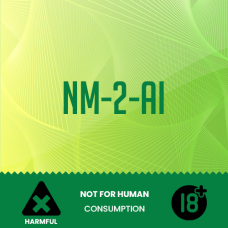Amphetamine research chemicals
NM-2AI
NM-AI, an acronym for N-Methyl-2-aminoindane, is a chemical compound belonging to the indole derivat..
£18.00
Understanding Amphetamines: A Guide to Research Chemicals
Amphetamines are a class of synthetic drugs that speed up the messages traveling from the body to the brain (and vice versa). Also known as central nervous system (CNS) stimulants, these drugs are normally used to increase alertness, concentration, and energy. But there’s much more to these chemicals than their medicinal uses.
These psycho-stimulants were first synthesized in 1887 in Germany by a Romanian chemist called Lazar Edeleanu. Since then, many researchers started studying amphetamines for their therapeutic effects, including their impact on brain function and human behavior. But what is the science behind these powerful stimulants? Read on for a detailed guide on amphetamines.
What Are Amphetamines?
Amphetamines are stimulant drugs that directly impact the central nervous system (CNS). They improve the rate at which messages are communicated between the body and brain. As a result, you feel more focused and alert, with increased energy levels.
Thanks to their impact on focus, alertness, and energy levels, amphetamines are useful in treating attention-deficit hyperactivity disorder (ADHD). For those with ADHD, amphetamines can help improve attention and focus, all while keeping the gratification impulses under control.
Besides, these psycho-stimulants are also used to treat many sleep disorders, including narcolepsy since they interact with neurons in the cerebral cortex. In other words, amphetamines are shown to treat the daytime sleepiness associated with narcolepsy.
History of Amphetamines
These stimulant drugs were synthesized in 1887 by a Romanian scientist. However, it wasn’t until 1929 when the chemical was discovered by Gordos Alles, that led to its widespread popularity. Soon after this, the stimulant was used by pharmaceutical companies in amphetamine medications. These were marketed as nasal decongestants and inhalers.
In fact, the drug was first sold under the name of Benzedrine7 as an inhaler in 1932. Shortly after this, the stimulating profile of the drug was noticed, which is when it started being used for other medicinal purposes. This includes treatment for attention-deficit hyperactivity disorder (ADHD) and narcolepsy.
How Do Amphetamines Work?
Before you buy amphetamines for research purposes, it is essential to understand the drug’s course of action. These psycho-stimulants basically affect three important neurotransmitters in the brain, including:
Dopamine is a feel-good substance in the brain that helps us feel pleasure. It works as the brain’s reward system, inducing feelings of motivation and happiness.
Norepinephrine is a main part of the body’s fight-or-flight mechanism, as it stimulates attention and response actions. It directly influences concentration and alertness.
Serotonin is a chemical messenger that works as a natural mood booster in the body. It also impacts sleep, digestion, pain perception, and overall well-being.
Mechanism of Action
The primary course of action of amphetamines is increasing the number of neurotransmitters (dopamine, norepinephrine, and serotonin) in the brain. To do this, these psycho-stimulants first approach the nerve cells. Here, they trigger the release of stored dopamine and norepinephrine into the synaptic cleft, which is the gap between the neurons.
Generally, once a neurotransmitter transmits its signal, it is reabsorbed by the neurons, thereby preventing overstimulation. Amphetamines block this reuptake process which leads to an accumulation of neurotransmitters in the synaptic cleft. Due to this increased concentration, the signaling effects of these neurotransmitters are prolonged on the postsynaptic neuron.
Besides, amphetamines also inhibit the activity of monoamine oxidase (MAO) — an enzyme that breaks down excess neurotransmitters. This way, the breakdown of dopamine, norepinephrine, and serotonin is reduced, and the level of these neurotransmitters gradually increases in the brain.
Different Types of Amphetamines
There are many different types of amphetamines, including medicinal and recreational drugs. Many of these are easily available at any research chemicals shop for chemists looking to explore the potential of these drugs. But before you buy research chemicals, let’s look at the types of amphetamines and what they are used for.
Methamphetamine: It is an FDA-unapproved drug that is commonly used for recreational purposes. The compound has a white, odorless nature and is available as chunky crystals (ice), powders, and pills.
Dextroamphetamine: It is an enantiomer of amphetamine with a slightly more pronounced stimulant profile than its parent compound. The drug is mostly used to treat narcolepsy and ADHD where it reduces impulsive behavior.
Lisdexamfetamine: This compound is an inactive prodrug, which is converted into dextroamphetamine before being metabolized in the body. It is useful for patients with binge eating disorder and ADHD.
Levoamphetamine: Previously sold as Cydril, this drug is almost a mirror image of dextroamphetamine but has a slightly less powerful psychostimulant profile. While it doesn’t work as well as a CNS stimulant, the compound is effective in targeting the peripheral nervous system. Here, it helps in vasoconstriction and vasopressin.
Medical Uses & Research Potential of Amphetamines
Amphetamines have a strong psycho-stimulant profile that makes them useful in many medical applications. Since they impact neurotransmitter levels in the brain, these drugs are considered a powerful treatment for narcolepsy, ADHD, and mental health conditions (like depression). Besides, there’s a lot of ongoing research surrounding this stimulant that aims to find out its potential in new therapeutic areas.
1. Treatment of Attention Deficit Hyperactivity Disorder (ADHD)
ADHD is a chronic developmental disorder where an individual is unable to sit and focus for extended periods. It is difficult to control oneself, which leads to impulsive decisions and hyperactivity. Amphetamines, like Adderall, are normally used to manage and regulate these symptoms. This drug increases the levels of dopamine and norepinephrine in the brain.
Since both of these neurotransmitters help increase concentration and pleasure response, you’re able to keep ADHD symptoms under control. The increased neurotransmitters in the prefrontal cortex also help improve attention spans and organization skills — something that many ADHD patients struggle with. Thus, amphetamines help improve their quality of life.
2. Management of Narcolepsy
Narcolepsy is a sleep disorder where you feel excessively sleepy during the day, even after a full night’s sleep. The condition affects your brain’s control over the sleep-wake cycles, making you fall asleep anytime, anywhere. Amphetamines promote wakefulness and reduce sleep attacks, which makes these drugs a valuable treatment for managing narcolepsy.
As discussed earlier, these psycho-stimulants increase the concentration of dopamine and norepinephrine in the brain. Both of these neurotransmitters improve alertness and decrease the overwhelming need to sleep during the day. As a result, amphetamines help individuals with narcolepsy stay awake for longer periods and participate in daily activities.
3. Potential in Treating Disorder
Depressive disorder is caused due to a low level of neurotransmitters in your brain, including serotonin, dopamine, and norepinephrine. The condition is often managed through over-the-counter antidepressants that target serotonin. However, scientists are now looking into the potential of amphetamines in treating depressive symptoms.
These CNS stimulants increase the levels of dopamine and norepinephrine, which in turn, improve depressive symptoms. In a recent study, 65 patients were treated with amphetamines. Out of these, 38 noticed a major improvement in symptoms, especially in psychomotor activity, mood, and energy.
4. Weight Management
Amphetamines have appetite-suppressing effects, which makes them great for weight loss. Since these drugs release norepinephrine in the brain, they trigger the body’s fight-or-flight response. This helps decrease hunger sensations and increase energy levels. Consequently, you’re able to burn calories faster than normal, which improves your body’s metabolism.
These drugs also improve stamina and physical activity, both of which aid in keeping body weight in check. However, the potential of amphetamines in weight loss is still under research and conclusive evidence is yet to be seen.
Conclusion
Amphetamines have a direct impact on the central nervous system (CNS) in the brain, stimulating the release of three critical neurotransmitters. These include serotonin, dopamine, and norepinephrine. A high concentration of these chemicals in the synaptic cleft helps manage symptoms of ADHD and narcolepsy, improving the quality of life of such patients.
Moreover, research is still ongoing to understand the potential of these psycho-stimulants in other therapeutic areas. However, with medical benefits, amphetamines also have a potential for misuse and addiction. This makes it crucial to stay informed and safe when dealing with the drug. If you want to buy research chemicals Europe, there is no better place than Express Highs.


